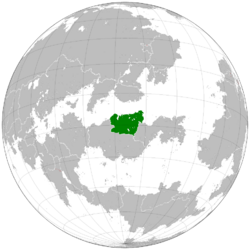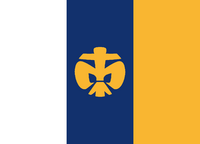Köthen
Parliamentary Republic of Köthen Parlamentarische Republik Köthen | |
|---|---|
|
Motto: "Freiheit oder Tod" Freedom or Death | |
 Map of Köthen on the globe (dark green) | |
| Capital and Largest City | Rudolberg |
| Official languages | Köthic |
| Recognised regional languages | Deiric |
| Religion |
|
| Demonym(s) | Köthic |
| Government | Parliamentary Republic |
| Wilhelm Bachinger | |
| Jakob Löwenthal | |
| Legislature | Bicameral Legislature |
| Senate | |
| House of Commons | |
| Establishment | |
• War of National Survival | 1909-1912 |
• Current Constitution | 1985 |
| Area | |
• | 1,550,485 km2 (598,646 sq mi) |
• Water (%) | 8.5 (2013) |
| Population | |
• 2023 estimate |
|
• 2020 census | 22.95 Million |
• Density | [convert: invalid number] |
| GDP (PPP) | 2020 estimate |
• Total |
|
• Per capita |
|
| GDP (nominal) | 2020 estimate |
• Total |
|
• Per capita |
|
| Gini (2020) |
medium |
| HDI (2020) |
very high |
| Currency | Bundesnote (Bdn) |
| Time zone | UTC-7 |
• Summer (DST) | UTC-6 |
| Date format | Day, month, year • Year, month, day |
| Driving side | right |
| Calling code | +13 |
| ISO 3166 code | KT |
| Internet TLD | .kt |
|
Website www.koethen.kt.gov | |
Köthen, officially the Parliamentary Republic of Köthen, is a nation situated along the Deyr Peninsula in central Verdantis. It is bordered by Vohylt-Tvahorner to the South and Deira to the East.
Several Proto-Köthen groups would inherit the region of Northern and Western Köthen during the First Age of Man and well into the Köthen Olde-Classical Era. A region known as Koed-then would be recorded in 340BC, the first Kingdoms in Köthen founded back in 350AD, followed by a series of wars, collapse and replacement of several Monarchs up to 1400AD.
Eventually the constant power struggle between the monarchs would reach a calm with the ascension of the House of Rein-Jarllen and the establishment of the Kingdom of Köthen. The Köthen Enlightenment lasting from 1400-1700 would be a time of relative peace and progress.
In 1810, a national identity for the Köthic would emerge in the kingdom. However the terminal decline in health of the only surviving heir of Rein-Jarllern, Henri V, threatened the stability of the nation. This potential for crisis eventually gave rise to a Regency which was enacted by Parliament to avert panic and collapse, the monarchy undergoing an administrative transition. This was the foundation for the establishment of the Parliamentary Republic of Köthen.
At the dawn of the 20th century, Köthen would face their revanchist neighbour of Reussland who prior to that, occupied and annexed both Eisenach and Vohylt-Tvahorner. They were next on Reussland's territorial conquests, getting in involved in Grindgat in 1909 with a defensive position. However, the Reussisch policies enacted onto their newly acquired states would begin crumbling substantially prior to the war.
As the Reussisch advanced through the Köthic frontline, the Lavender Revolution came into full swing, cutting off the troops stationed for the front and disrupting much needed supplies and logistics for the advance. Using the opportunity, Köthen Military forces began a counteroffensive with the assistance of the Vohylt-Tvahorner Patriotic Army, the war ending in 1915 with the continued sovereignty of Köthen remaining.


